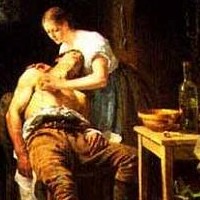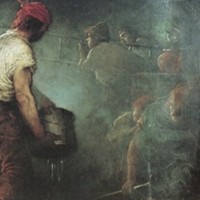Henry Jones Thaddeus
Irish Portrait Artist, Landscape Painter,
Genre Paintings, Orientalist: Biography and Pictures.
![]()
![]()
|
Henry Jones Thaddeus |
 The Wounded Poacher (1881). By Henry Jones Thaddeus One of the great Irish Artists of the 19th Century. |
Henry Jones Thaddeus RHA (1859-1929)The Irish portrait artist, plein-air landscape/subject painter and Orientalist Henry Thaddeus Jones (who later altered his name to its present form), was born in Cork city and entered the Cork School of Art at the age of 11 under James Brenan where he trained in freehand drawing and copying from classical sculpture. At 20, he won the prestigious Royal Dublin Society (RDS) Taylor Prize, which enabled him to advance his painting career with further study at Heatherly's Academy in London, from where he made his way to Paris and enrolled at the Academie Julian. Here he trained under the French masters Gustave Boulanger and Charles Lefebvre. While still a student, Thaddeus exhibited a Parisian townscape at the RDS, and another work (The Wounded Poacher) at the Paris Salon (1881) to some acclaim as a master of realism. |
 An Irish Eviction (1889). |
|
In the same year, Thaddeus left Paris for the artist colony at Pont Aven in Brittany, later visited by Roderic O'Conor (1860-1940). Finding it drab and boring, he quickly moved to Concarneau - later home to William John Leech (1881-1968) - to develop his figurative work, before returning to Paris. Not long afterwards he visited Italy for 18-months to study Renaissance art in Florence. By this time he had developed into an outstanding plein-air artist, while also excelling at studio portraiture, which brought him considerable commercial success. He greatly enjoyed mixing with the aristocracy of Europe, whose portraits he painted and exhibited in various venues including the Royal Academy in London. In 1885 he moved to Cannes on the French Riviera, crossing to Algeria after the earthquake in Nice, where he explored Orientalist painting, before ending up in Rome, where he mingled easily among the Italian nobility. |
|
In Rome he painted portraits of both Pope Leo XIII, and Father Arderledy, the head of the Jesuits. He also took time to submit several works to the Royal Hibernian Academy (RHA). By 1887, Thaddeus was settled and painting portraits out of his studios in South Kensington, London, although he continued travelling throughout the late 1880s and 1890s - taking in Morocco, Egypt (where he was appointed official painter to the Khedive, Abbas II Hilmi), Corsica, Germany, India and even Australia. He was even elected a Fellow of the Royal Geopgraphical Society. However, despite his wanderings, he still found time to show regularly at the RHA, where in 1892 he was elected an Associate Member, and in 1901 a full Academician. In 1907 he emigrated to California with his wife and family and, in 1912, published his autobiography 'Recollections of a Court Painter' which contained a fascinating account of his time as a Parisian student, his later travels, as well as his experience as a society portraitist in Rome and London. In 1917 ill-health caused him to return to England, and he settled in the Isle of Wight. He died there 12 years later at the age of 63. Regarded as one of the top Irish artists of the 19th Century, Thaddeus is today known mainly for his aristocratic portraiture. He produced a wide range of work, including genre paintings and Oriental pictures as well as biblical works. One of his greatest masterpieces was 'An Irish Eviction, Co Galway (1889), a dramatic depiction of the land war in Ireland during the 1880s. |
|
• For more biographies, see: Homepage. ENCYCLOPEDIA OF VISUAL ARTISTS IN IRELAND |